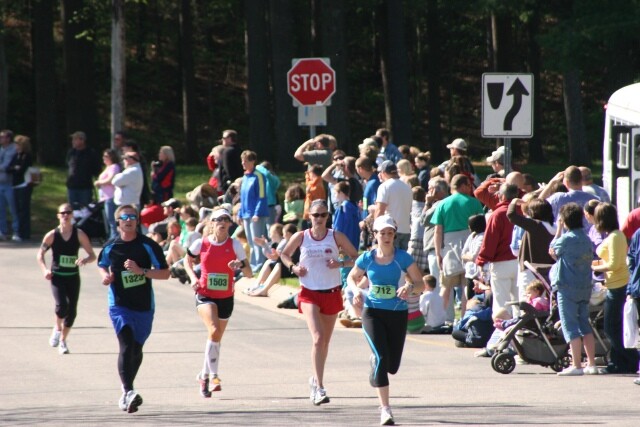Spectating: An Endurance Sport of its Own
without people to watch, races are just training sessions with strangers

I am an elite member of the competitive world of distance race spectating. I have worked my way to the first wave of watchers.
In my life, I am surrounded by endurance athletes. My husband rowed crew in college, and still runs, bikes, and skis competitively. His sister still rows in Masters events. My daughter and my friend, Nick Anderson, have both competed in marathons and triathlons. I watch. My small cadre of athletes includes course-record holders, a former world-record holder, and a couple of middle-of-the-pack hobbyists. I’ve stood in rain, sleet, heat, and snow to watch my racer go by in a flash or a near-crawl, or to not go by at all. I’ve got a couple of Ironmans under my belt, a few Birkebeiners (a 35-mile cross-country ski race in northern Wisconsin in February), and a winter ultramarathon, where I was the only spectator to follow my racer the entire 35 miles. I’ve raced on the Metro in Washington, D.C. to catch the end of a marathon (and missed it), and I’ve stood alone in the dark on a snow-packed trail in the middle of a national forest.
“Most importantly, be a great fan! Make a sign for your racer and cheer loudly for every single racer who goes by. Come up with an encouraging mantra and repeat it … 100 or 200 times, if necessary. Racers love encouragement, even if – or especially when – they’re too beat to acknowledge it.”
Why would I wait in the middle of nowhere for hours on end just to see one person go by once (or maybe twice, if the race is designed well for spectators)? Because races need me. They need spectators, or the event is nothing more than an elaborate training session with strangers. More importantly, my friends and family need support.
Most spectators are fair-weather friends – literally. They’re the kind who will plop down a soccer-mom chair in the sun, sipping a latte on a street corner and texting on their phones until their friend comes by, but will stay home if it’s drizzling. I am an endurance watcher. I show up, regardless of weather, and I last until the bitter end. Oh, there are a few of my kind, and we recognize each other, meeting up at numerous spots along the course, and nodding respectfully, as if to say, “You are my brethren, my people. You are as crazy as I am. And you love your racer as much as I love mine.”
Race spectating done right is actually really hard work. Rural races present unique challenges. It’s bad enough having to brave extreme weather, but navigating a course that winds on county highways and dirt trails can be tricky. Sometimes streets are closed for the race, which forces you to find alternate routes, glancing at a map while law-enforcement vehicles are tailgating you and the roads all have three names. Some races provide better maps than others.
Urban races can be fun. Navigating is easier, but parking, traffic, and crowd congestion become concerns. I flew to Washington, D.C., just to watch my daughter run a marathon and missed her finish because a Metro train just never came.

The most challenging part of spectating for endurance races is timing. You want to beat your racer to the next point, so you have to choose your spots carefully. Often races will go off-road, so your racer has a shortcut while you have to take roads. Figuring split times, plus driving distances, plus routes add stress. And once you’ve made it to your spot, you have to watch Every. Single. Racer. In bike races, they fly by and it’s easy to miss your target. If you’ve been waiting a really long time, you begin to worry whether you missed him. Did he go by in a pack, or did he get a flat? Did you miss her, or did she crash? You always need to figure your break point before you have to move again, because if you get behind your racer, you will miss him at every stop and miss the finish. At my daughter’s first triathlon in Philadelphia, we nervously waited an eternity for her to come by on her second loop of the bike course. Ready to move on, I pulled out my cell phone and saw six missed calls from an unknown number. She had crashed badly and was in the medical tent.
No matter the race, I am always wiped out at the end. I, too, leave it all on the course.
So how can you be a better spectator? Well first of all, plan your race. All good athletes need a strategy, and so do you. Know the course. Have a good map. Discuss split times and good viewing points with your racer. If you’re a cyclist, biking is a great way to get around many marathons. Plan for your own needs as well. Bring a chair, all-weather apparel (rain gear, blankets, sun screen, etc.), some food and water. Scope out porta-potties before the race as it may be your last chance for a while.
Most importantly, be a great fan! Make a sign for your racer and cheer loudly for every single racer who goes by. Come up with an encouraging mantra and repeat it … 100 or 200 times, if necessary. Racers love encouragement, even if – or especially when – they’re too beat to acknowledge it.
And a word to race designers: Providing good maps, a spectator-friendly route, accessible parking, plenty of porta-potties, and informed course workers all increase the quality and popularity of an event.
The long and short of it is that spectating can be cold, exhausting, and lonely. It can be both boring and stressful. But it is essential. A race is not a race without fans. And it can mean the world to your racer.
My personal record came last fall, watching my friend, Nick, do his second Ironman. But this time he pulled Halden, his friend with cerebral palsy, the entire 140 miles of swimming, biking, and running. For 15 hours, 47 minutes, and 45 seconds, I ran, drove, and biked, cheering the entire way.
My next even – standing in the snow for five hours trying to spot my husband, Joe, flying by on skis during next month’s Birkebeiner – should be a piece of cake in comparison.

